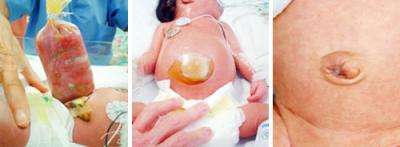Innovative treatment for abdominal birth defect prevents scarring

(PhysOrg.com) -- Pediatric surgeons at Lucile Packard Children's Hospital have adopted a sutureless technique for treating gastroschisis, a birth defect in which the bowels protrude through a hole in the abdomen.
The results, which include no scarring and a faster time to extubation, are very encouraging, said Sanjeev Dutta, MD, a pediatric surgeon at the hospital. “It’s a game changer,” he said.
Normally, the hole is closed with stitches after the intestine has been put back. But sutures tend to put a lot of pressure on the abdominal organs. “It’s like buttoning up jeans that are too small for you,” Dutta said.
As a result, the infants may have trouble breathing, and they may need to be medically paralyzed to prevent them from wiggling too much, which can tear the stitches. They also need to be anesthetized for the surgery, which leaves a prominent scar on the stomach.
Over the last few years, however, Dutta and his colleagues have used a technique that allows the abdominal-wall opening to close without sutures. Instead, the hole is dressed with the remnants of the umbilical cord and one or two large, plastic occlusive bandages. If there is not enough umbilical cord to cover the defect, the surgeons can dress it with an absorbent, polyurethane-foam bandage, and put the occlusive bandage on top.
“Then, we just let nature do its work,” Dutta said, adding that no anesthesia is required.
In a retrospective study of 43 newborns treated for gastroschisis at Packard Children’s, lead author Dutta and his colleagues found that the time to extubation was cut in half for those who underwent the sutureless procedure. (The results of that study are published in the October 2009 issue of the Journal of Pediatric Surgery.) He is now conducting a large, randomized study of sutureless-versus-sutured repair of gastroschisis to make a better determination of which works best.
Interestingly, the sutureless technique should probably not be called new, Dutta said. Although a 2004 paper in the Journal of Pediatric Surgery is largely credited with having fostered interest in the technique, Dutta and his co-authors point out that as early as 1878, William Fear, MD, wrote in the British Medical Journal about using the umbilical cord to dress the gastroschisis defect.
“In effect, it’s a method that has just been rediscovered,” Dutta said.















